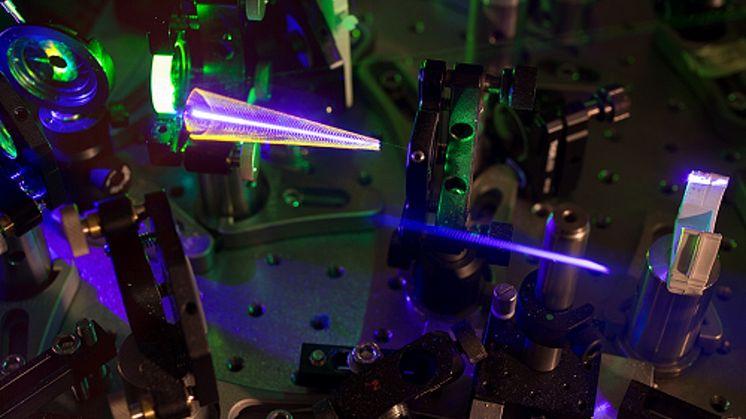
Press release -
New system for generating ultra-fast flashes of light discovered
New system for generating ultra-fast flashes of light discovered
An international research team consisting of the Institute of Photonics and Nanotechnology of the CNR (CNR-IFN), the Politecnico di Milano, the DESY in Hamburg and the Massachusetts Institute of Technology has managed to synthesise “optical waveforms” by means of the synchronised overlap of different light pulses. These light pulses, which can be “sculpted” according to the user’s wishes, will be used to study atomic and molecular processes. The results have been published in Nature Photonics
Since its invention in 1960, the laser has revolutionised not only the fields of science and technology, but also our everyday lives, with applications ranging from medicine to materials processing, fibre-optic communications to the preservation of our cultural heritage. One of the laser’s many exceptional properties is that it allows the user to generate incredibly short flashes of light, up to a duration of just a few femtoseconds, i.e. a few millionths of a billionth of a second. These pulses, thanks to their extremely short duration, allow us to study ultra-fast phenomena, such as the processes underlying vision and photosynthesis, and can, thanks to their extremely high intensity, modify atoms and molecules in order to create new states of matter. As such, controlling the properties and the temporal profile of these pulses is of utmost scientific and technological importance, and has been the object of intense study since the 1980s.
An international team of scientists involving the Politecnico di Milano, the Institute of Photonics and Nanotechnology of the CNR (CNR-IFN), the DESY in Hamburg and the Massachusetts Institute of Technology has managed to synthesise genuine ‘optical waveforms’ by controlling the electrical field of the light with an extremely high degree of precision, much less than a femtosecond. The results have been published in the journal Nature Photonics. The synthesis of these waveforms is based on an innovative optical process pioneered by the researchers from the CNR and the Politecnico: coherent synthesis, i.e. the synchronised overlap of different light pulses.
“It’s like directing an orchestra. Each pulse is a musical instrument, called upon to produce its own sound; coherent synthesis is the perfect execution of a piece of music. This orchestra could potentially produce an infinite multitude of waveforms - that is, melodies. As such, the coherent synthesis achieved in these experiments is a very promising approach for the generation of laser light pulses of any shape and duration,” explains Cristian Manzoni, researcher at the CNR-IFN and the Politecnico.
Many years of work went into the experiment. “We built the first prototype - which was the start of everything - right in the laboratories of the Politecnico di Milano,” adds Giulio Cerullo from the Department of Physics at the Politecnico di Milano. “It was like a little ensemble, but from that first experiment, published in 2012, came the idea to put together the large orchestra we have now. The experimental apparatus was reconstructed and expanded at the laboratories in Hamburg”.
The waveforms that can now be synthesised will increase the opportunities to control the way light interacts with matter, especially at high intensities. In this case, the electromagnetic field of the light is so strong that it can counteract the forces that bind electrons to nuclei; the light can temporarily remove electrons from the atom and cause them to orbit along brand new trajectories. For example, it has been demonstrated that when the electron moves propelled by such short and intense waveforms, it generates even shorter light pulses lasting just a few attoseconds, in other words billionths of a billionth of a second. These are the shortest artificial events that man has ever been capable of creating. This research is laying the foundations for the study of new atomic and molecular mechanisms, in that it will allow us to examine nature through light pulses that are “sculpted” according to the user’s wish.
Factsheet
Who: Institute of Photonics and Nanotechnology of the CNR (CNR-IFN), the Politecnico di Milano, the DESY in Hamburg and the Massachusetts Institute of Technology
What: “Sub-cycle mJ-level Parametric Waveform Synthesizer for Attosecond Science”, an article published in Nature Photonics; DOI: 10.1038 / s41566-020-0659-0.
https://www.nature.com/articles/s41566-020-0659-0, https://rdcu.be/b5Awh
Topics
Categories
Politecnico di Milano is a scientific-technological university which trains engineers, architects and industrial designers.
The University has always focused on the quality and innovation of its teaching and research, developing a fruitful relationship with business and productive world by means of experimental research and technological transfer.
Research has always been linked to didactics and it is a priority commitment which has allowed Politecnico Milano to achieve high quality results at an international level as to join the university to the business world. Research constitutes a parallel path to that formed by cooperation and alliances with the industrial system.
Knowing the world in which you are going to work is a vital requirement for training students. By referring back to the needs of the industrial world and public administration, research is facilitated in following new paths and dealing with the need for constant and rapid innovation. The alliance with the industrial world, in many cases favored by Fondazione Politecnico and by consortiums to which Politecnico belong, allows the university to follow the vocation of the territories in which it operates and to be a stimulus for their development.
The challenge which is being met today projects this tradition which is strongly rooted in the territory beyond the borders of the country, in a relationship which is developing first of all at the European level with the objective of contributing to the creation of a single professional training market. Politecnico takes part in several research, sites and training projects collaborating with the most qualified European universities. Politecnico's contribution is increasingly being extended to other countries: from North America to Southeast Asia to Eastern Europe. Today the drive to internationalization sees Politecnico Milano taking part into the European and world network of leading technical universities and it offers several courses beside many which are entirely taught in English.

